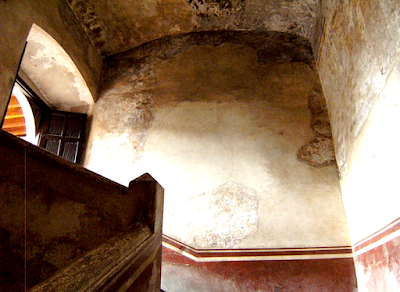For the last of our posts on the Acolman murals we consider the celebrated frescoes of the upper rear cloister.

Arcades smoothly fashioned from warm gray limestone distinguish the brilliantly lit rear patio at Acolman. Clustered columns ornamented with Isabelline pearls, feather capitals separate a sequence of sharply cut reliefs that explore variations on the Augustinian pierced heart motif and the crucifix.
The Upper Cloister
A handsome stone staircase, also lined with vestiges of murals, leads to the upper story, where a spectacular cycle of late 16th century frescoes (after 1570) narrating the central drama of Christianity—the Passion of Christ—unfolds around the walks.
A handsome stone staircase, also lined with vestiges of murals, leads to the upper story, where a spectacular cycle of late 16th century frescoes (after 1570) narrating the central drama of Christianity—the Passion of Christ—unfolds around the walks.
Adapted from Northern European engravings and painted in charcoal tones with blue and tan accents, all are amply framed by columns, friezes and grotesque panels painted blue/black.
The sequence begins in the southeast corner, with the Scourging of Christ—a flogging administered by two robust Roman soldiers—and beside it, the Mocking of Christ, where again Romans affix the Crown of Thorns.
But the best preserved frescoes are in the northwest corner. Most notable is a conventionally posed, rather static Renaissance-style Crucifixion, enlivened by the background landscape.
But the best preserved frescoes are in the northwest corner. Most notable is a conventionally posed, rather static Renaissance-style Crucifixion, enlivened by the background landscape.
The anguished figure of Mary Magdalene kneels at the foot of the cross, her long auburn hair tumbling down like an ocher mane, while the Sun and Moon look down from above. Although set against a crowded Italianate landscape of steeples, trees and grottoes, the distinctive hill beside the cross resembles the local sacred mountain of Cerro Chiconautla.
The Last Judgment, on the other hand, is tumultuous medieval drama. In the upper panel Christ sits in majesty atop a rainbow with sword and scepter among the massed ranks of the Blessed. A Latin banner proclaims the damnation of sinners to eternal fire while the dead struggle from their coffins.
The Last Judgment, on the other hand, is tumultuous medieval drama. In the upper panel Christ sits in majesty atop a rainbow with sword and scepter among the massed ranks of the Blessed. A Latin banner proclaims the damnation of sinners to eternal fire while the dead struggle from their coffins.
Underneath, against a black background, the naked white bodies of the Damned suffer unspeakable torments: demons with grasping claw and gaping jaws tie their victims to trees, break them on the wheel and toss them into a steaming cauldron. Confronted with this nightmarish vision, who would not strive for salvation?
See our other posts on portrayals of the Last Judgment : Xoxoteco; El Llanito; Totimehuacan; Suchixtlahuaca; Huaquechula; Yanhuitlan; Cuitzeo; Ixmiquilpan;
text © 2018 Richard D. Perry. images by the author, Robert Jackson and others











No comments:
Post a Comment